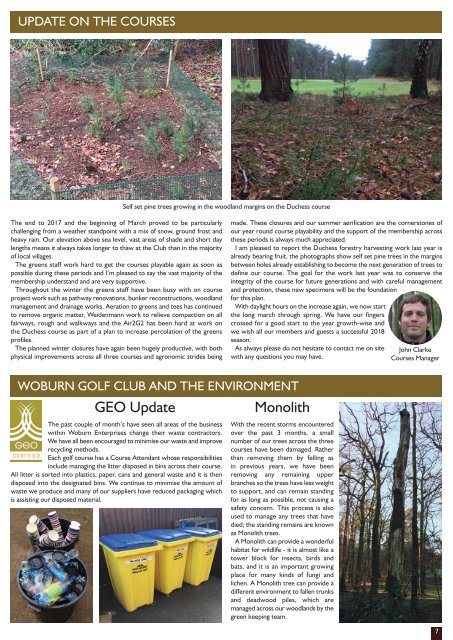WGC NEWS 04-18
You also want an ePaper? Increase the reach of your titles
YUMPU automatically turns print PDFs into web optimized ePapers that Google loves.
UPDATE ON THE COURSES<br />
Self set pine trees growing in the woodland margins on the Duchess course<br />
The end to 2017 and the beginning of March proved to be particularly<br />
challenging from a weather standpoint with a mix of snow, ground frost and<br />
heavy rain. Our elevation above sea level, vast areas of shade and short day<br />
lengths means it always takes longer to thaw at the Club than in the majority<br />
of local villages.<br />
The greens staff work hard to get the courses playable again as soon as<br />
possible during these periods and I’m pleased to say the vast majority of the<br />
membership understand and are very supportive.<br />
Throughout the winter the greens staff have been busy with on course<br />
project work such as pathway renovations, bunker reconstructions, woodland<br />
management and drainage works. Aeration to greens and tees has continued<br />
to remove organic matter, Weidenmann work to relieve compaction on all<br />
fairways, rough and walkways and the Air2G2 has been hard at work on<br />
the Duchess course as part of a plan to increase percolation of the greens<br />
profiles.<br />
The planned winter closures have again been hugely productive, with both<br />
physical improvements across all three courses and agronomic strides being<br />
made. These closures and our summer aerification are the cornerstones of<br />
our year round course playability and the support of the membership across<br />
these periods is always much appreciated.<br />
I am pleased to report the Duchess forestry harvesting work last year is<br />
already bearing fruit, the photographs show self set pine trees in the margins<br />
between holes already establishing to become the next generation of trees to<br />
define our course. The goal for the work last year was to conserve the<br />
integrity of the course for future generations and with careful management<br />
and protection, these new specimens will be the foundation<br />
for this plan.<br />
With daylight hours on the increase again, we now start<br />
the long march through spring. We have our fingers<br />
crossed for a good start to the year growth-wise and<br />
we wish all our members and guests a successful 20<strong>18</strong><br />
season.<br />
As always please do not hesitate to contact me on site<br />
with any questions you may have.<br />
John Clarke<br />
Courses Manager<br />
WOBURN GOLF CLUB AND THE ENVIRONMENT<br />
GEO Update<br />
The past couple of month’s have seen all areas of the business<br />
within Woburn Enterprises change their waste contractors.<br />
We have all been encouraged to minimise our waste and improve<br />
recycling methods.<br />
Each golf course has a Course Attendant whose responsibilities<br />
include managing the litter disposed in bins across their course.<br />
All litter is sorted into plastics, paper, cans and general waste and it is then<br />
disposed into the designated bins. We continue to minimise the amount of<br />
waste we produce and many of our suppliers have reduced packaging which<br />
is assisting our disposed material.<br />
Monolith<br />
With the recent storms encountered<br />
over the past 3 months, a small<br />
number of our trees across the three<br />
courses have been damaged. Rather<br />
than removing them by felling as<br />
in previous years, we have been<br />
removing any remaining upper<br />
branches so the trees have less weight<br />
to support, and can remain standing<br />
for as long as possible, not causing a<br />
safety concern. This process is also<br />
used to manage any trees that have<br />
died; the standing remains are known<br />
as Monolith trees.<br />
A Monolith can provide a wonderful<br />
habitat for wildlife - it is almost like a<br />
tower block for insects, birds and<br />
bats, and it is an important growing<br />
place for many kinds of fungi and<br />
lichen. A Monolith tree can provide a<br />
different environment to fallen trunks<br />
and deadwood piles, which are<br />
managed across our woodlands by the<br />
green keeping team.<br />
7


